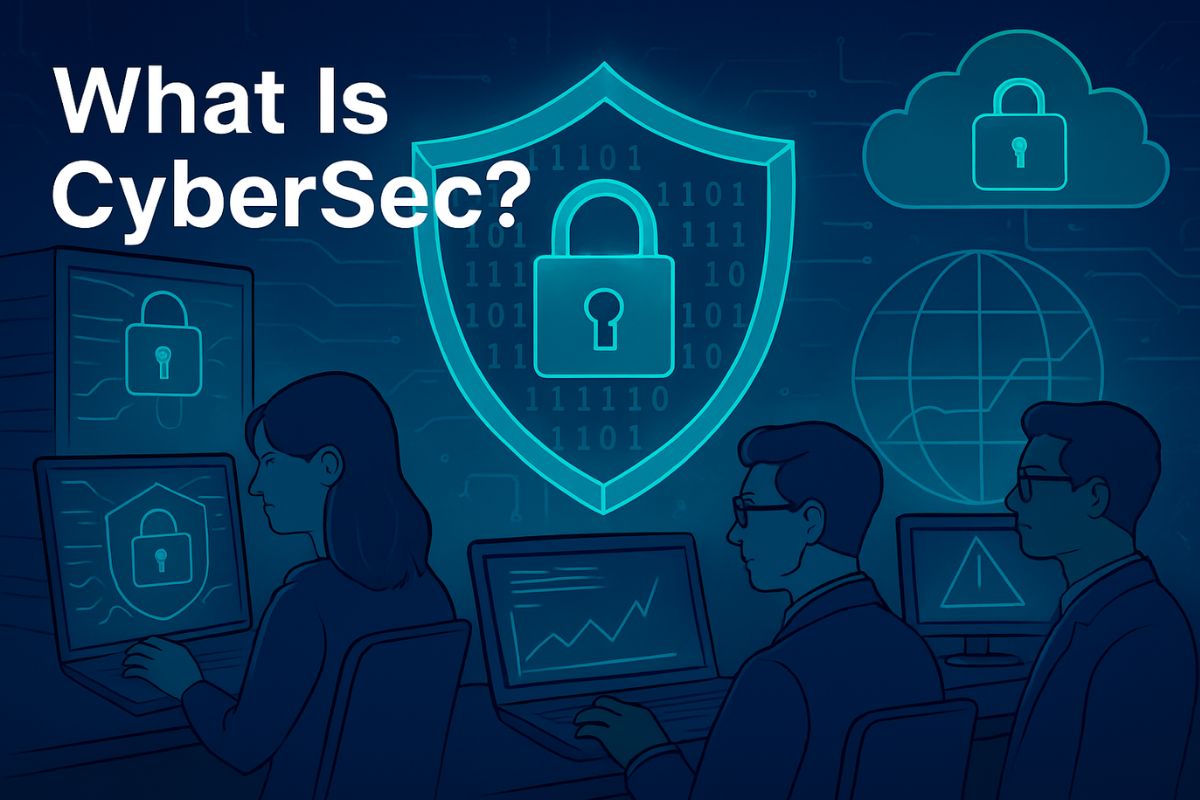CyberSec, short for Cyber Security, encompasses the tools, technologies, and strategies used to protect digital systems, networks, and data from cyber threats. From personal device protection to national security infrastructure, understanding what is cybersec helps you navigate today’s connected world with confidence. This blog explores its definition, importance, challenges, and relationship with broader cyber security, using real-world context and terminology suited for every curious Indian reader.
Have you ever clicked a suspicious link or received a shady message saying your bank account will be blocked? You’re not alone. In today’s hyper-connected digital world, threats lurk everywhere—from personal smartphones to national data centers. This is where CyberSec comes in.
But what is cybersec, really? Is it just a fancy abbreviation or a separate field altogether? Let’s dive deep into this buzzword, break down what it really means, how it’s different (or not) from cyber security, and how it protects everything from your Facebook account to India’s national security systems.
Whether you’re a student, working professional, entrepreneur, or just curious, this blog will answer all your questions and help you stay cyber-aware.
What Is CyberSec? A Deep Dive into the Basics
CyberSec is a shorthand term often used to refer to Cyber Security. However, in modern usage, especially in technical and military circles, CyberSec can sometimes refer to the broader strategic approach to cyber defense, not just tools and software.
Definition:
CyberSec is the practice of defending digital systems, networks, and data from malicious attacks using a combination of technology, policies, training, and best practices.
How It’s Used in Real Life:
| CyberSec Domain | Real-World Example | Purpose |
|---|---|---|
| Personal Devices | Antivirus software, 2FA | Protect user data |
| Businesses | Firewalls, SIEM tools | Prevent data breaches |
| Government | National Cyber Command | Defend critical infrastructure |
| Education | Cyber awareness in schools | Build digital hygiene culture |
CyberSec vs Cyber Security: Is There a Difference?
Key Differences and Similarities
| Feature | CyberSec | Cyber Security |
|---|---|---|
| Abbreviation | Short form (slang/technical jargon) | Full term |
| Usage | Popular in IT/military fields | Standard usage in general public |
| Scope | Sometimes used to refer to tactical security operations | Broad umbrella term for all digital security practices |
| Relevance | Growing in modern vocabulary | Universally accepted term |
In essence:
CyberSec = Cyber Security
But “CyberSec” is increasingly being used in fast-paced industries where terminology needs to be short, precise, and strategic.
Why Is CyberSec Important in Today’s World?
1. Increase in Cyber Threats
- Phishing
- Ransomware
- Data breaches
- Identity theft
- Deepfake fraud
2. Growth of Digital India
With initiatives like Digital India, PM-WANI, and Aadhaar, our dependency on digital infrastructure has surged. This makes cyber what? A real challenge!
3. Rise in Remote Work & BYOD (Bring Your Own Device)
- Greater attack surface
- More vulnerabilities in unsecured home networks
4. Personal Data Protection
Your name, PAN, Aadhaar, banking info—everything is stored online now. CyberSec helps ensure it’s not leaked or sold on the dark web.
What Are the Core Components of CyberSec?
1. Network Security
Ensures safe and uninterrupted network communication using firewalls, intrusion detection systems, and VPNs.
2. Information Security (InfoSec)
Protects data integrity, confidentiality, and availability.
3. Application Security
Prevents unauthorized access and code exploitation in software applications.
4. Identity & Access Management (IAM)
Limits access to information using authentication tools (like OTPs and biometrics).
5. User Awareness & Training
The human firewall—educating users to recognize threats.
Real-Life CyberSec Scenarios in India
1. Cosmos Bank Cyber Attack (2018)
Hackers siphoned ₹94 crore via malware and ATM withdrawals.
2. Aadhaar Data Leak
Millions of Aadhaar numbers were leaked through API vulnerabilities.
3. Air India Data Breach (2021)
Over 4.5 million customers’ data compromised.
These examples emphasize: what is cybersec is no longer just an IT question—it’s a societal concern.
Careers in CyberSec: India’s Booming Job Market
In-Demand Roles:
- Cyber Security Analyst
- Ethical Hacker
- SOC (Security Operations Center) Analyst
- Penetration Tester
- Chief Information Security Officer (CISO)
Required Skills:
- Knowledge of networks, coding (Python, Java)
- Familiarity with tools like Wireshark, Burp Suite
- Certifications: CEH, CompTIA Security+, CISSP
CyberSec Tools You Should Know
| Tool Name | Use Case | Indian Context |
|---|---|---|
| Kali Linux | Penetration testing | Ethical hacking training |
| Nmap | Network scanning | Detecting open ports |
| Wireshark | Packet analysis | Educational institutions |
| Burp Suite | Web app security | Startup security audits |
Benefits of Understanding CyberSec
- Personal safety online
- Better career opportunities
- Secure digital payments
- Protection from fraud
- Boosted national cyber hygiene
FAQs: People Also Ask
1. What is cybersec in simple words?
CyberSec is the practice of protecting computers, networks, and data from digital attacks or theft.
2. Is cybersec and cyber security the same?
Yes, cybersec is a short form of cyber security, often used in technical and casual conversations.
3. What does cyber what mean in cybersec?
It refers to anything related to digital or online environments—like cyber threats, cyber laws, etc.
4. What is cyber used for?
Cyber is used as a prefix to describe anything related to digital technology, e.g., cybersecurity, cybercrime.
5. Why is cybersec important for students?
It helps students avoid online fraud, secure their data, and prepare for tech careers.
6. Can I get a job in cybersec without coding?
Yes, roles like compliance, audit, and security operations don’t always require deep coding knowledge.
7. Which course is best for cybersec?
Courses like CEH, CISSP, and Diploma in Cyber Security by NIELIT are great starting points in India.
8. What are the challenges in Indian cybersec?
Poor awareness, lack of skilled professionals, and growing digitalization are key challenges.
9. How is cybersec evolving in India?
Government projects, private sector demand, and increasing cybercrime awareness are rapidly expanding the cybersec landscape.
10. Is cybersec only for IT people?
No, cybersec is for everyone—from smartphone users to CEOs. It impacts daily life.
Conclusion: Stay Aware, Stay Secure
Now that you understand what is cybersec and how deeply it’s tied to cyber security, you’re better equipped to protect yourself in the digital world. In India’s rapidly growing digital ecosystem, being cyber-aware is no longer optional—it’s essential.
Have thoughts or questions? Drop a comment below or share this blog with someone who needs to level up their cyber awareness. Let’s build a safer digital future together!



